| |
|
Open-Source Electromagnetic Simulators:
|
| |
|
VoxImp: It is a fast Fourier transform
(FFT)-accelerated impedance extractor for voxelized structures.
See above the slide show for the details. Click
here
to download the initial version of VoxImp or
here
to go to github repository. |
| |
|
VoxHenry: It is a fast Fourier transform
(FFT)-accelerated inductance extractor for voxelized structures.
See above the slide show for the details. Click
here
to download the initial version of VoxHenry or
here
to go to github repository. It is currently being incorporated
into the open-source fastfieldsolvers software.
|
| |
|
VoxCap: It is a Tucker decomposition-enhanced and FFT-accelerated capacitance extractor for voxelized structures.
See above the slide show for the details. Click
here
to download the initial version of VoxCap or
here
to go to github repository .
|
|
|
|
Open-Source Deep Learning-Based Forward and Inverse
Solvers:
|
| |
|
3DInvNet: It is a
two stage 3D CNN/U-net-based ground-penetrating radar (GPR)
inversion scheme to obtain the underground target's
permittivity distribution from 3D GPR C-scans. The
first stage of the scheme denoises the C-scan and
second stage of the scheme provides the permittivity
distribution of the target corresponding to C-scan. Click
here
to go to github repository. |
| |
|
DMRF-UNet: It is a
two stage 2D U-net-based ground-penetrating radar (GPR)
inversion scheme to obtain the underground target's
permittivity distribution from GPR B-scans. The
first stage of the scheme denoises the B-scan and
second stage of the scheme provides the permittivity
distribution of the target corresponding to B-scan. Click
here
to go to github repository. |
| |
|
DeeptDCS: It is a
U-net based 3D forward solver which takes the volume
conductor model of human head (processed from MRI)
and electrode positions of transcranial direct
current stimulation (tDCS) procedure as inputs. It
provides the current distribution throughout the
head model as output. For given any volume conductor
model of any subject, it provides the current
distribution instantaneously. Such real-time
simulator is ideal for clinical and research
settings when the practitioners want to see the
current distribution on the head instantaneously. Click
here
to go to github repository.
|
| |
|
GPR forward solver: It is a
U-net based 2D GPR forward solver which takes the
permittivity and conductivity maps of the
underground environment as inputs. It
instantaneously provides the B-scan for the given
underground scenario as output. Click
here
to go to github repository.
|
| |
| |

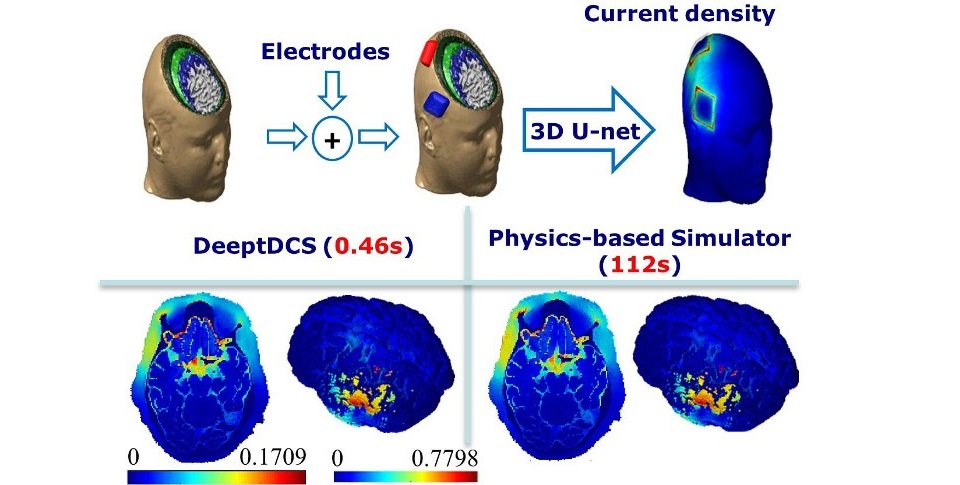 It is a U-net based 3D forward solver which takes the volume conductor model of human head (processed from MRI) and electrode positions of transcranial direct current stimulation (tDCS) procedure as inputs. It provides the current distribution throughout the head model as output. For given any volume conductor model of any subject, it provides the current distribution instantaneously..
It is a U-net based 3D forward solver which takes the volume conductor model of human head (processed from MRI) and electrode positions of transcranial direct current stimulation (tDCS) procedure as inputs. It provides the current distribution throughout the head model as output. For given any volume conductor model of any subject, it provides the current distribution instantaneously..
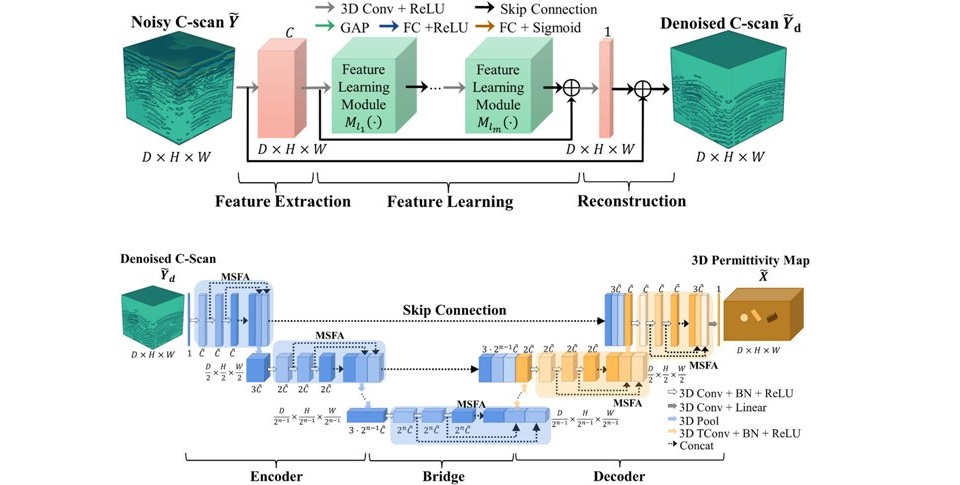 It is a two stage 3D CNN/U-net-based ground-penetrating radar (GPR) inversion scheme to obtain the underground target's permittivity distribution from 3D GPR C-scans. The first stage of the scheme denoises the C-scan and second stage of the scheme provides the permittivity distribution of the target corresponding to C-scan.
It is a two stage 3D CNN/U-net-based ground-penetrating radar (GPR) inversion scheme to obtain the underground target's permittivity distribution from 3D GPR C-scans. The first stage of the scheme denoises the C-scan and second stage of the scheme provides the permittivity distribution of the target corresponding to C-scan.
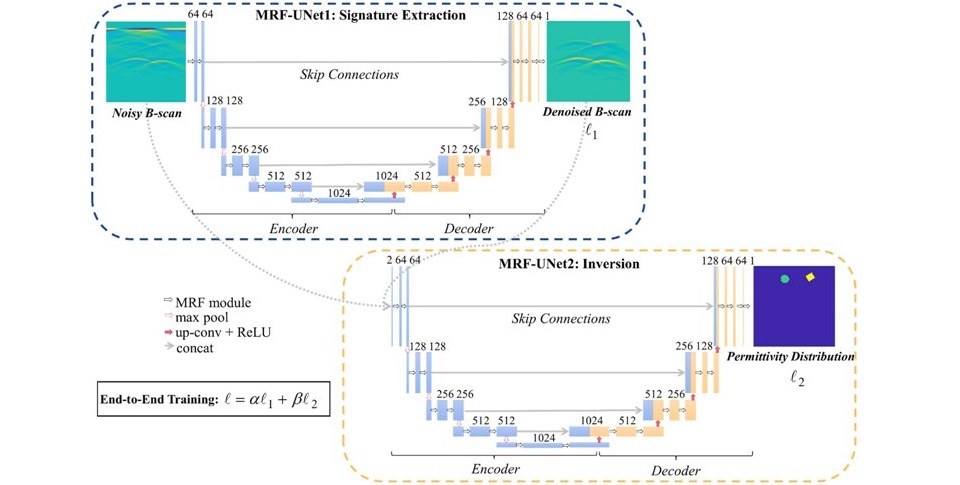 It is a two stage 2D U-net-based ground-penetrating radar (GPR) inversion scheme to obtain the underground target's permittivity distribution from GPR B-scans. The first stage of the scheme denoises the B-scan and second stage of the scheme provides the permittivity distribution of the target corresponding to B-scan.
It is a two stage 2D U-net-based ground-penetrating radar (GPR) inversion scheme to obtain the underground target's permittivity distribution from GPR B-scans. The first stage of the scheme denoises the B-scan and second stage of the scheme provides the permittivity distribution of the target corresponding to B-scan.
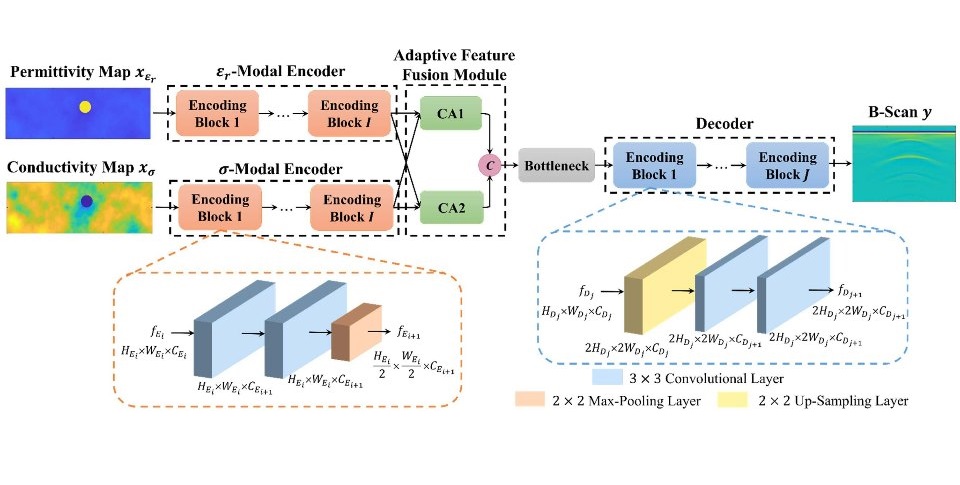 It is a U-net based 2D GPR forward solver which takes the permittivity and conductivity maps of the underground environment as inputs. It instantaneously provides the B-scan for the given underground scenario as output.
It is a U-net based 2D GPR forward solver which takes the permittivity and conductivity maps of the underground environment as inputs. It instantaneously provides the B-scan for the given underground scenario as output.
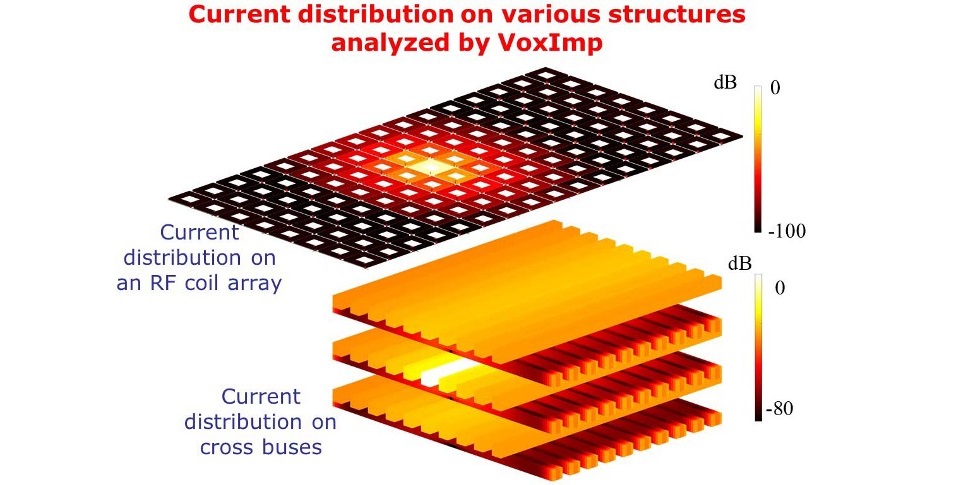 The developed simulator called VoxImp is a Matlab-based Tucker-enhanced and FFT-accelerated impedance extractor for the structures discretized by voxels.
The developed simulator called VoxImp is a Matlab-based Tucker-enhanced and FFT-accelerated impedance extractor for the structures discretized by voxels.
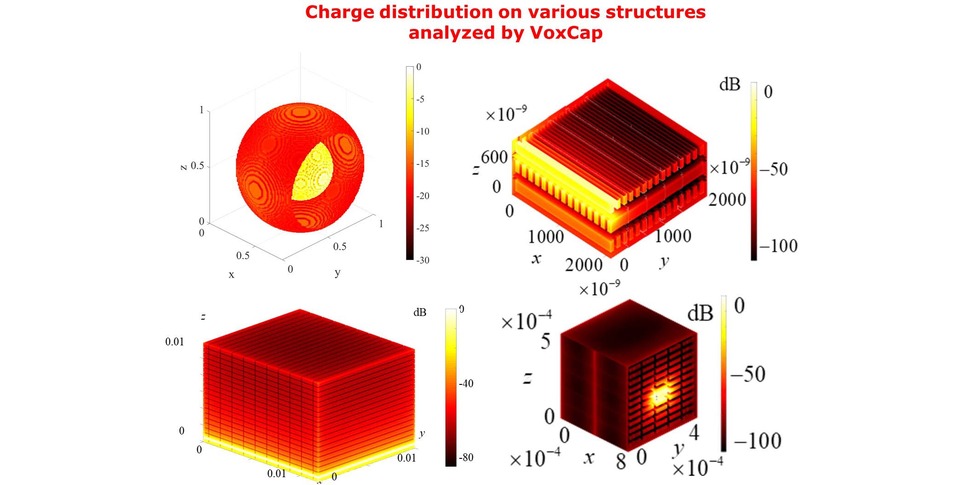 The developed simulator called VoxCap is a Matlab-based Tucker-enhanced and FFT-accelerated capacitance extractor for the structures discretized by voxels. Unlike its popular predecessor FastCap, it can be operated with voxel-based virtual fabrication environments.
The developed simulator called VoxCap is a Matlab-based Tucker-enhanced and FFT-accelerated capacitance extractor for the structures discretized by voxels. Unlike its popular predecessor FastCap, it can be operated with voxel-based virtual fabrication environments.
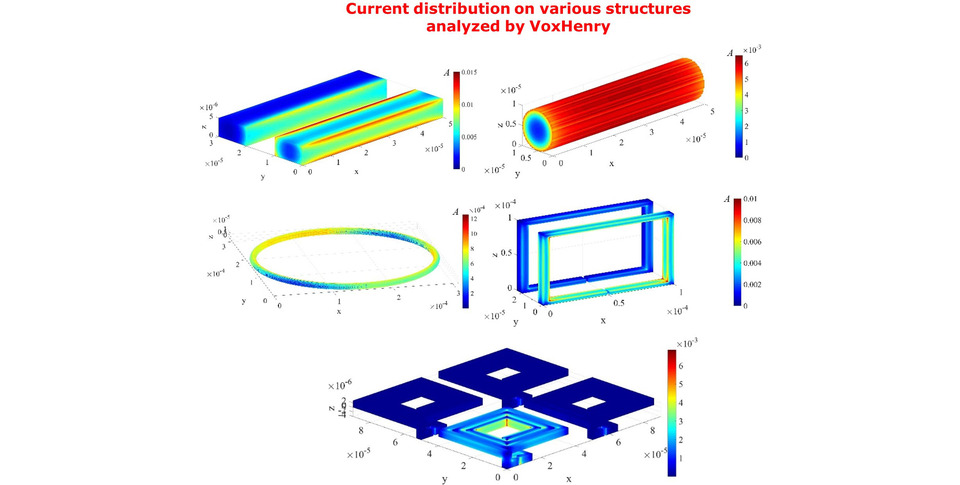 The developed simulator called VoxHenry is a Matlab-based FFT-accelerated inductance extractor for the structures discretized by voxels. Unlike its popular predecessor FastHenry, it can be operated with voxel-based virtual fabrication environments and it is capable of efficiently analyzing arbitrarily shaped structures with sharp bends.
The developed simulator called VoxHenry is a Matlab-based FFT-accelerated inductance extractor for the structures discretized by voxels. Unlike its popular predecessor FastHenry, it can be operated with voxel-based virtual fabrication environments and it is capable of efficiently analyzing arbitrarily shaped structures with sharp bends.
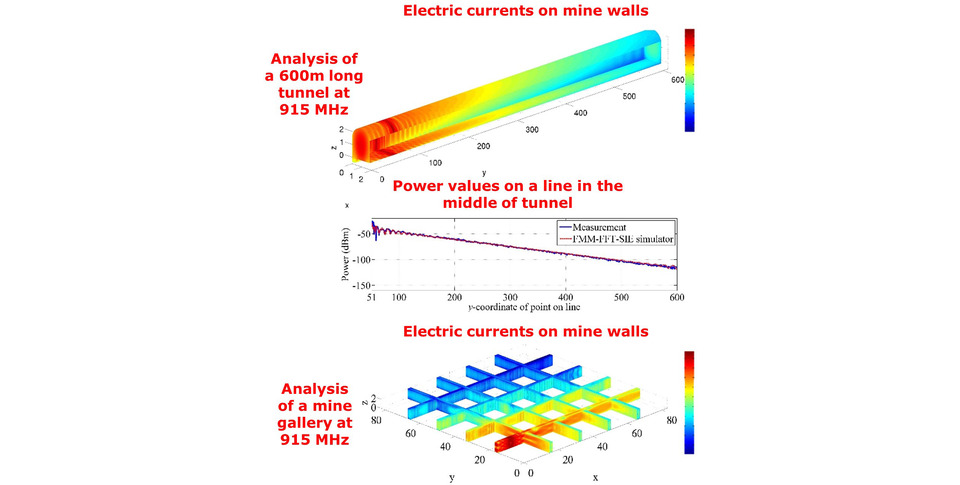 A full-wave EM simulator for characterizing EM wave propagation in large-scale mine tunnels (and galleries) loaded with conductors was developed. Different from traditional IE based simulators, the simulator uses special compression schemes for analyzing larger tunnels. It is suitable to be used for indoor wireless channel characterization.
A full-wave EM simulator for characterizing EM wave propagation in large-scale mine tunnels (and galleries) loaded with conductors was developed. Different from traditional IE based simulators, the simulator uses special compression schemes for analyzing larger tunnels. It is suitable to be used for indoor wireless channel characterization.
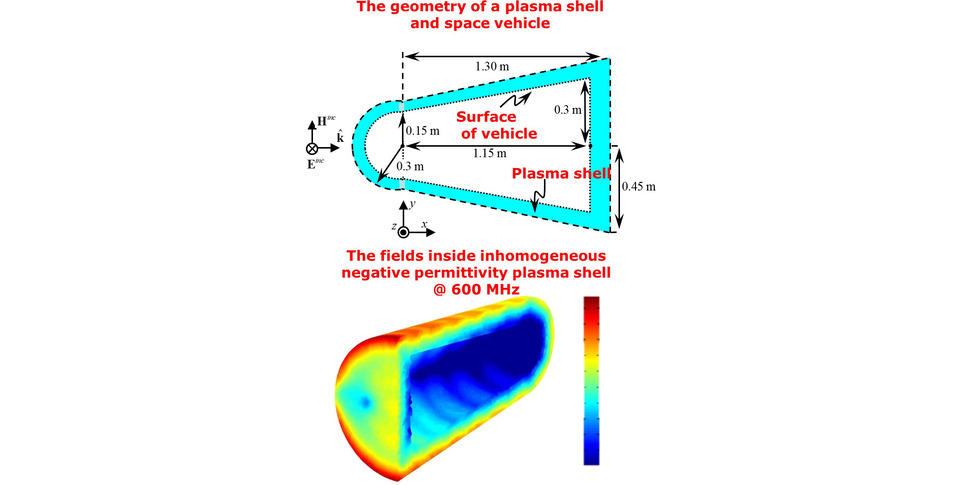 The analysis of a plasma engulfed re-entry space vehicle was not possible with the traditional IE simulators when the permittivity of plasma was negative valued. We developed a full-wave IE based EM simulator that made this analysis possible now. The simulator is developed to be used for the design and on-platform analysis of antennas mounted on re-entry space vehicles. Consequently, it will be used to study the communication blackout phenomenon that happens when the space vehicles re-enter the atmosphere.
The analysis of a plasma engulfed re-entry space vehicle was not possible with the traditional IE simulators when the permittivity of plasma was negative valued. We developed a full-wave IE based EM simulator that made this analysis possible now. The simulator is developed to be used for the design and on-platform analysis of antennas mounted on re-entry space vehicles. Consequently, it will be used to study the communication blackout phenomenon that happens when the space vehicles re-enter the atmosphere.
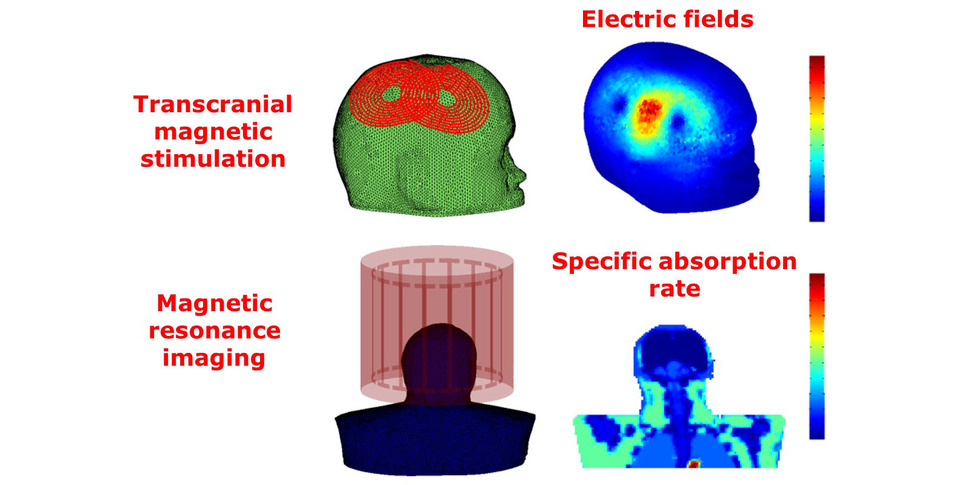 We developed a broadband general purpose EM simulator for EM analysis of various biomedical procedures (including magnetic resonance imaging, transcranial magnetic stimulation, neuromuscular electrical stimulation and so on). Unlike traditional IE-based EM simulators, it can be operated at any frequency for any tissue permittivity values.
We developed a broadband general purpose EM simulator for EM analysis of various biomedical procedures (including magnetic resonance imaging, transcranial magnetic stimulation, neuromuscular electrical stimulation and so on). Unlike traditional IE-based EM simulators, it can be operated at any frequency for any tissue permittivity values.
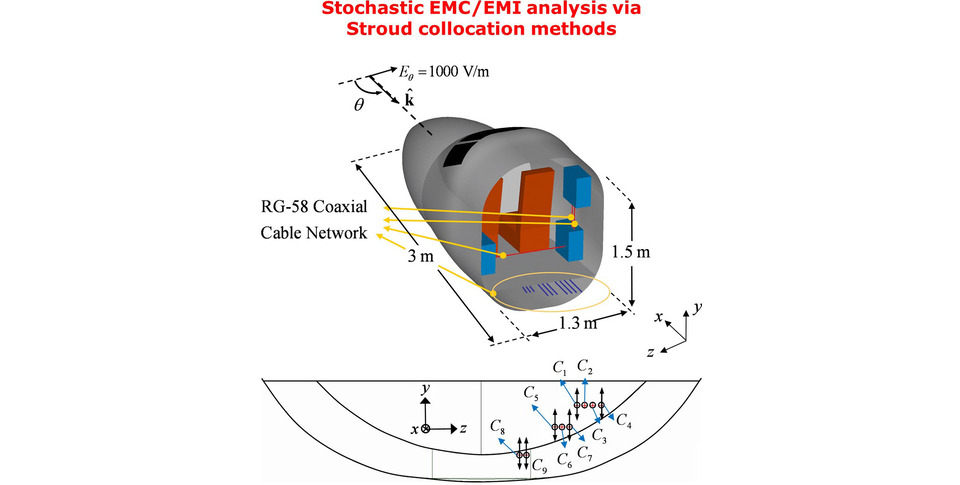 We developed a Stroud-based stochastic collocation framework. We applied it to stochastic analysis of various electromagnetic compatibility and interference (EMC/EMI) problems including the statistical characterization of fields coupled to coaxial cables in an airplane cockpit. Stroud stochastic collocation methods are highly efficient and accurate given that the QoIs vary smoothly in the random domain.
We developed a Stroud-based stochastic collocation framework. We applied it to stochastic analysis of various electromagnetic compatibility and interference (EMC/EMI) problems including the statistical characterization of fields coupled to coaxial cables in an airplane cockpit. Stroud stochastic collocation methods are highly efficient and accurate given that the QoIs vary smoothly in the random domain.
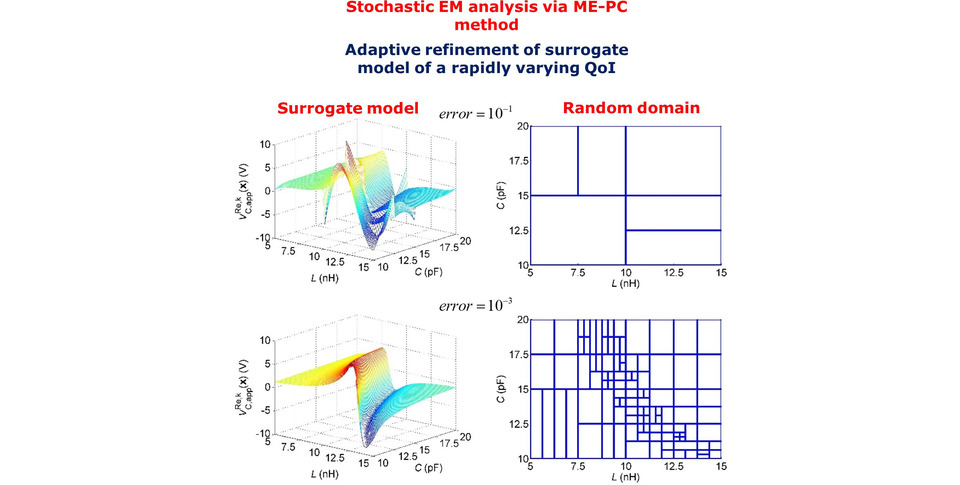 Stochastic collocation methods lack accuracy and efficiency when the QoIs vary rapidly and/or are discontinuous functions of random variables. To tackle with this problem, we developed an ME-PC based stochastic framework for EM analysis. This framework effectively tailors the collocation points on random domains and is highly efficient and accurate given that the QoIs vary smoothly or rapidly. We applied this framework to the statistical characterization of EMC/EMI phenomenon on real-world platforms and EM wave propagation in mine tunnels.
Stochastic collocation methods lack accuracy and efficiency when the QoIs vary rapidly and/or are discontinuous functions of random variables. To tackle with this problem, we developed an ME-PC based stochastic framework for EM analysis. This framework effectively tailors the collocation points on random domains and is highly efficient and accurate given that the QoIs vary smoothly or rapidly. We applied this framework to the statistical characterization of EMC/EMI phenomenon on real-world platforms and EM wave propagation in mine tunnels.
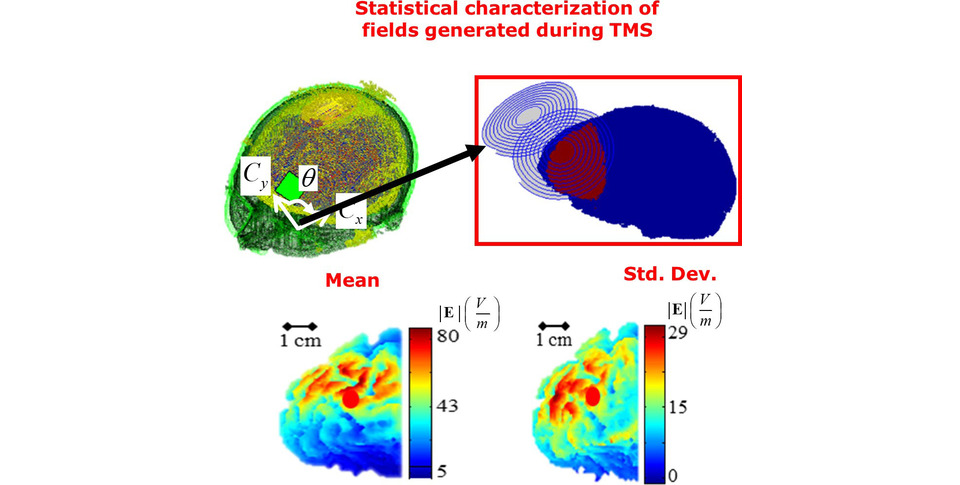 The collocation based methods lack accuracy and efficiency when the number of random variables (or uncertain input parameters) is large. To this end, we developed an iterative HDMR based stochastic framework and used it for statistical characterization of multiconductor transmission line networks and electric fields generated during TMS procedures. The developed framework allows efficiently generating the surrogate models of QoIs given that the QoIs can be approximated by low-order correlations of random variables.
The collocation based methods lack accuracy and efficiency when the number of random variables (or uncertain input parameters) is large. To this end, we developed an iterative HDMR based stochastic framework and used it for statistical characterization of multiconductor transmission line networks and electric fields generated during TMS procedures. The developed framework allows efficiently generating the surrogate models of QoIs given that the QoIs can be approximated by low-order correlations of random variables.


